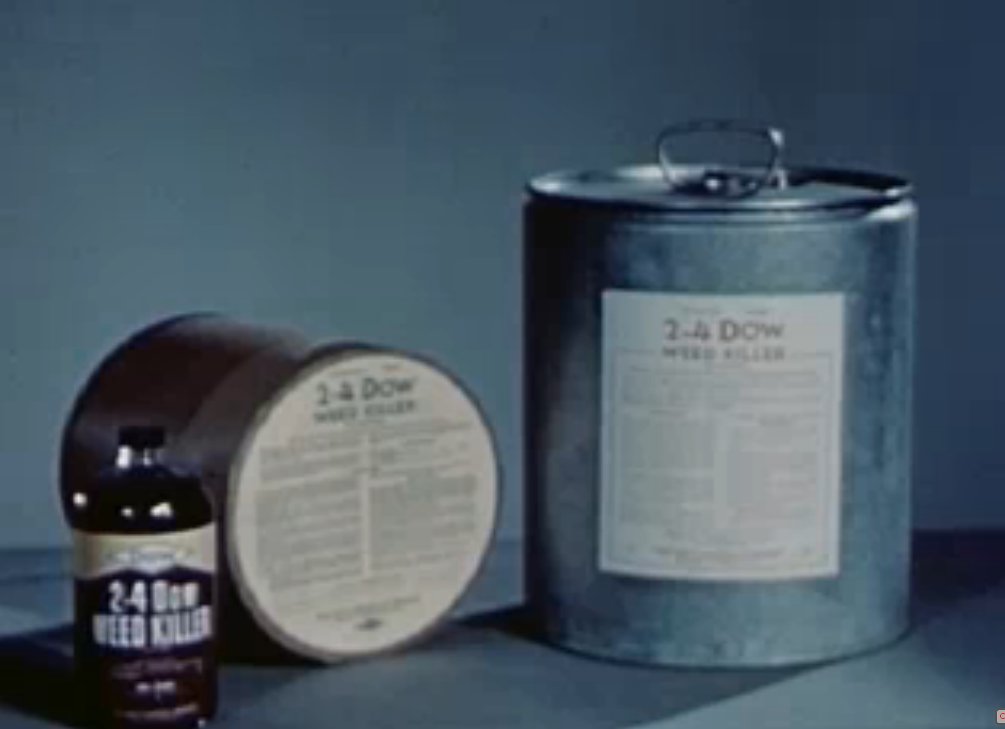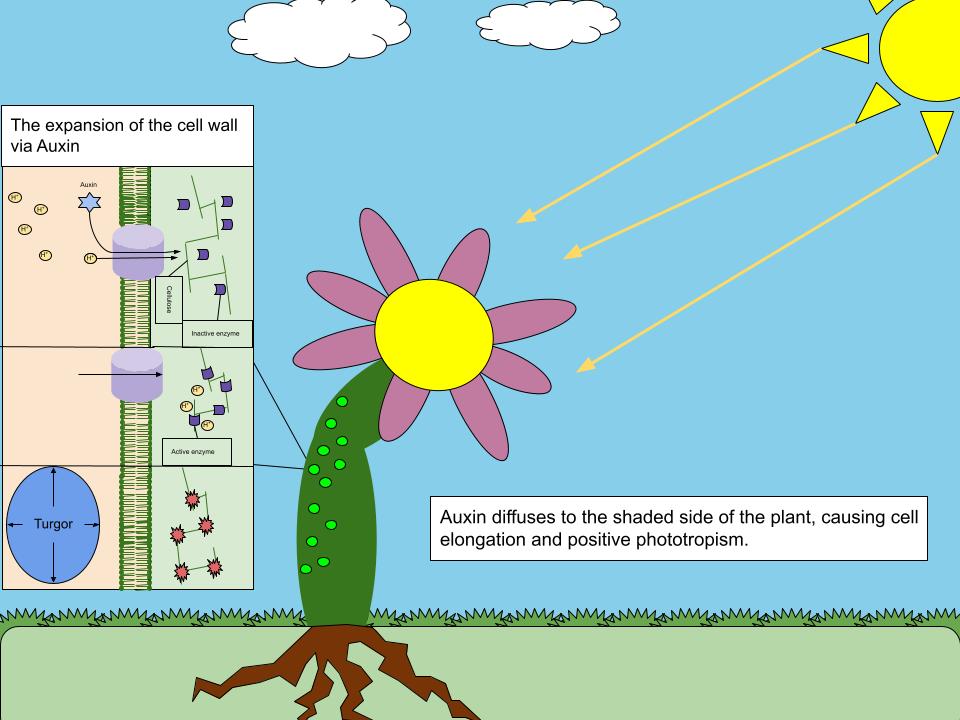|
2,4-D
2,4-Dichlorophenoxyacetic acid is an organic compound with the chemical formula . It is usually referred to by its ISO common name 2,4-D. It is a systemic herbicide that kills most broadleaf weeds by causing uncontrolled growth, but most grasses such as cereals, lawn turf, and grassland are relatively unaffected. 2,4-D is one of the oldest and most widely available herbicides and defoliants in the world, having been commercially available since 1945, and is now produced by many chemical companies since the patent on it has long since expired. It can be found in numerous commercial lawn herbicide mixtures, and is widely used as a weedkiller on cereal crops, pastures, and orchards. Over 1,500 herbicide products contain 2,4-D as an active ingredient. History 2,4-D was first reported in 1944 by Franklin D. Jones at the C. B. Dolge Company in Connecticut. The biological activity of 2,4-D as well as the similar hormone herbicides 2,4,5-T, and MCPA were discovered during World W ... [...More Info...] [...Related Items...] OR: [Wikipedia] [Google] [Baidu] |
Herbicide
Herbicides (, ), also commonly known as weed killers, are substances used to control undesired plants, also known as weeds.EPA. February 201Pesticides Industry. Sales and Usage 2006 and 2007: Market Estimates. Summary in press releasMain page for EPA reports on pesticide use ihere Selective herbicides control specific weed species while leaving the desired crop relatively unharmed, while non-selective herbicides (sometimes called "total weed killers") kill plants indiscriminately. The combined effects of herbicides, nitrogen fertilizer, and improved cultivars has increased yields (per acre) of major crops by three to six times from 1900 to 2000. In the United States in 2012, about 91% of all herbicide usage, was determined by weight applied, in agriculture. In 2012, world pesticide expenditures totaled nearly US$24.7 billion; herbicides were about 44% of those sales and constituted the biggest portion, followed by insecticides, fungicides, and fumigants. Herbicide is also used ... [...More Info...] [...Related Items...] OR: [Wikipedia] [Google] [Baidu] |
Auxin
Auxins (plural of auxin ) are a class of plant hormones (or plant-growth regulators) with some morphogen-like characteristics. Auxins play a cardinal role in coordination of many growth and behavioral processes in plant life cycles and are essential for plant body development. The Dutch biologist Frits Warmolt Went first described auxins and their role in plant growth in the 1920s. Kenneth V. Thimann became the first to isolate one of these phytohormones and to determine its chemical structure as indole-3-acetic acid (IAA). Went and Thimann co-authored a book on plant hormones, ''Phytohormones'', in 1937. Overview Auxins were the first of the major plant hormones to be discovered. They derive their name from the Greek word ( – 'to grow/increase'). Auxin is present in all parts of a plant, although in very different concentrations. The concentration in each position is crucial developmental information, so it is subject to tight regulation through both metabolism and transp ... [...More Info...] [...Related Items...] OR: [Wikipedia] [Google] [Baidu] |
Phenoxy Herbicide
Phenoxy herbicides (or "phenoxies") are two families of chemicals that have been developed as commercially important herbicides, widely used in agriculture. They share the part structure of phenoxyacetic acid. Auxins The first group to be discovered act by mimicking the auxin growth hormone indoleacetic acid (IAA). When sprayed on broad-leaf plants they induce rapid, uncontrolled growth ("growing to death"). Thus when applied to monocotyledonous crops such as wheat or maize (corn), they selectively kill broad-leaf weeds, leaving the crops relatively unaffected. File:Indol-3-ylacetic acid.svg, IAA File:2-(4-chloro-2-methylphenoxy)acetic acid 200.svg, MCPA File:2-(2,4-dichlorophenoxy)acetic acid 200.svg, 2,4-D File:2-(2,4,5-trichlorophenoxy)acetic acid 200.svg, 2,4,5-T Introduced in 1946, these herbicides were in widespread use in agriculture by the middle of the 1950s. The best known phenoxy herbicides are (4-chloro-2-methylphenoxy)acetic acid (MCPA), 2,4-dichlorophenoxyacetic aci ... [...More Info...] [...Related Items...] OR: [Wikipedia] [Google] [Baidu] |
Defoliant
A defoliant is any herbicidal chemical sprayed or dusted on plants to cause their leaves to fall off. Defoliants are widely used for the selective removal of weeds in managing croplands and lawns. Worldwide use of defoliants, along with the development of other herbicides and pesticides, allowed for the Green Revolution, an increase in agricultural production in mid-20th century. Defoliants have also been used in warfare as a means to deprive an enemy of food crops and/or hiding cover, most notably by the United Kingdom during the Malayan Emergency and the United States in the Vietnam War. Defoliants were also used by Indonesian forces in various internal security operations. Use and application A primary application of defoliants is the selective killing of plants. Two of the oldest chemical herbicides used as defoliants are 2,4-Dichlorophenoxyacetic acid (2,4-D) and 2,4,5-Trichlorophenoxyacetic acid (2,4,5-T). 2,4-D and 2,4,5-T are absorbed by broad-leafed plants, killin ... [...More Info...] [...Related Items...] OR: [Wikipedia] [Google] [Baidu] |
Dichlorprop
Dichlorprop is a chlorophenoxy herbicide similar in structure to 2,4-D that is used to kill annual and perennial broadleaf weeds. It is a component of many common weedkillers. About 4 million pounds of dichlorprop are used annually in the United States. Chemistry Dichlorprop possesses a single asymmetric carbon and is therefore a chiral molecule, however only the ''R''-isomer is active as an herbicide. When dichlorprop was first marketed in the 1960s, it was sold as racemic mixture of stereoisomers, but since then advances in asymmetric synthesis have made possible the production of the enantiopure compound. Today, only ''R''-dichlorprop (also called dichlorprop-p or 2,4-DP-p) and its derivatives are sold as pesticides in the United States. Dichlorprop is a carboxylic acid, and like related herbicides with free acid groups, it is often sold as a salt or ester. Currently, the 2-ethylhexyl ester is used commercially. The butoxyethyl and isooctyl esters were once popular, but ar ... [...More Info...] [...Related Items...] OR: [Wikipedia] [Google] [Baidu] |
MCPA
MCPA (2-methyl-4-chlorophenoxyacetic acid) is a widely used phenoxy herbicide introduced in 1945. It selectively controls broad-leaf weeds in pasture and Cereal, cereal crops. The mode of action of MCPA is as an auxin, which are growth hormones that naturally exist in plants. History In 1936 investigations began at Imperial Chemical Industries, ICIs Jealott's Hill research center into the effects of auxins on plant growth looking specifically for a way to kill weeds without harming crops such as wheat and oats. William Templeman found that when indole-3-acetic acid (IAA), the naturally occurring auxin, was used at high concentrations, it could stop plant growth. In 1940, he published his finding that IAA killed broadleaf plants within a cereal field. Templeman and the ICI group were searching for compounds with similar or greater selective activity than IAA or 1-naphthaleneacetic acid in inhibiting the growth of weeds while not adversely affecting the growth of cereal crops. The ... [...More Info...] [...Related Items...] OR: [Wikipedia] [Google] [Baidu] |
2,4,5-T
2,4,5-Trichlorophenoxyacetic acid (also known as 2,4,5-T), a synthetic auxin, is a chlorophenoxy acetic acid herbicide used to defoliate broad-leafed plants. It was developed in the late 1940s, synthesized by reaction of 2,4,5-trichlorophenol and chloroacetic acid. It was widely used in the agricultural industry until being phased out, starting in the late 1970s due to toxicity concerns. Agent Orange, a defoliant used by the British in the Malayan Emergency and the U.S. in the Vietnam War, was equal parts 2,4,5-T and 2,4-D (2,4-dichlorophenoxyacetic acid). 2,4,5-T itself is toxic with a NOAEL of 3 mg/kg/day and a LOAEL of 10 mg/kg/day. Agent Pink contained 100% 2,4,5-T (dioxin contaminates included). Additionally, the manufacturing process for 2,4,5-T contaminates this chemical with trace amounts of 2,3,7,8-tetrachlorodibenzo-''p''-dioxin (TCDD). TCDD is a carcinogenic persistent organic pollutant with long-term effects on the environment. With proper temperat ... [...More Info...] [...Related Items...] OR: [Wikipedia] [Google] [Baidu] |
Indole-3-acetic Acid
Indole-3-acetic acid (IAA, 3-IAA) is the most common naturally occurring plant hormone of the auxin class. It is the best known of the auxins, and has been the subject of extensive studies by plant physiologists. IAA is a derivative of indole, containing a carboxymethyl substituent. It is a colorless solid that is soluble in polar organic solvents. Biosynthesis IAA is predominantly produced in cells of the apex ( bud) and very young leaves of a plant. Plants can synthesize IAA by several independent biosynthetic pathways. Four of them start from tryptophan, but there is also a biosynthetic pathway independent of tryptophan. Plants mainly produce IAA from tryptophan through indole-3-pyruvic acid. IAA is also produced from tryptophan through indole-3-acetaldoxime in ''Arabidopsis thaliana''. In rats, IAA is a product of both endogenous and colonic microbial metabolism from dietary tryptophan along with tryptophol. This was first observed in rats infected by '' Trypanosoma br ... [...More Info...] [...Related Items...] OR: [Wikipedia] [Google] [Baidu] |
Rothamsted Research
Rothamsted Research, previously known as the Rothamsted Experimental Station and then the Institute of Arable Crops Research, is one of the oldest agricultural experiment station, agricultural research institutions in the world, having been founded in 1843. It is located at Harpenden in the English county of Hertfordshire and is a Charitable organization, registered charity under English law. Two of the station's best known and longest-running experiments are the Broadbalk Experiment, planted annually with winter wheat since 1843, and the Park Grass Experiment, a biological study that started in 1856 and has been continuously monitored ever since. History The Rothamsted Experimental Station was founded in 1843 by John Bennet Lawes, a noted Victorian era entrepreneur and scientist who had founded one of the first artificial fertilizer manufacturing factories in 1842, on his 16th-century estate, Rothamsted Manor, to investigate the impact of inorganic and organic fertilizers on ... [...More Info...] [...Related Items...] OR: [Wikipedia] [Google] [Baidu] |
Lawn
A lawn () is an area of soil-covered land planted with Poaceae, grasses and other durable plants such as clover lawn, clover which are maintained at a short height with a lawn mower (or sometimes grazing animals) and used for aesthetic and recreational purposes—it is also commonly referred to as part of a garden. Lawns are usually composed only of grass species, subject to weed control, weed and pest control, maintained in a green color (e.g., by Irrigation, watering), and are regularly mowed to ensure an acceptable length. Lawns are used around houses, apartments, commercial buildings and offices. Many city parks also have large lawn areas. In recreational contexts, the specialised names Sod, turf, parade, pitch, field or green may be used, depending on the sport and the continent. The term "lawn", referring to a managed grass space, dates to at least the 16th century. With suburban expansion, the lawn has become culturally ingrained in some areas of the world as part o ... [...More Info...] [...Related Items...] OR: [Wikipedia] [Google] [Baidu] |
Grassland
A grassland is an area where the vegetation is dominance (ecology), dominated by grasses (Poaceae). However, sedge (Cyperaceae) and rush (Juncaceae) can also be found along with variable proportions of legumes such as clover, and other Herbaceous plant, herbs. Grasslands occur naturally on all continents except Antarctica and are found in most ecoregions of the Earth. Furthermore, grasslands are one of the largest biomes on Earth and dominate the landscape worldwide. There are different types of grasslands: natural grasslands, semi-natural grasslands, and agricultural grasslands. They cover 31–69% of the Earth's land area. Definitions Included among the variety of definitions for grasslands are: * "...any plant community, including harvested forages, in which grasses and/or legumes make up the dominant vegetation." * "...terrestrial ecosystems dominated by herbaceous and shrub vegetation, and maintained by fire, grazing, drought and/or freezing temperatures." (Pilot Assessm ... [...More Info...] [...Related Items...] OR: [Wikipedia] [Google] [Baidu] |






